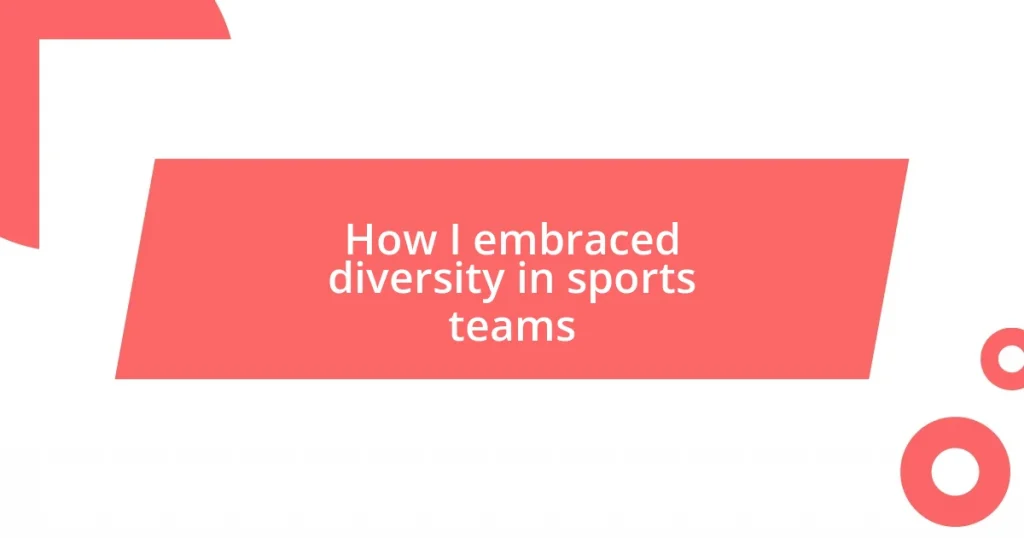Key takeaways:
- Diversity enhances team performance by introducing varied perspectives and innovative approaches during challenges.
- Building an inclusive team culture involves intentional actions like celebrating individual differences and promoting open dialogues.
- Success in diverse teams is measured not just by performance statistics, but by the quality of relationships, trust, and a sense of belonging among players.
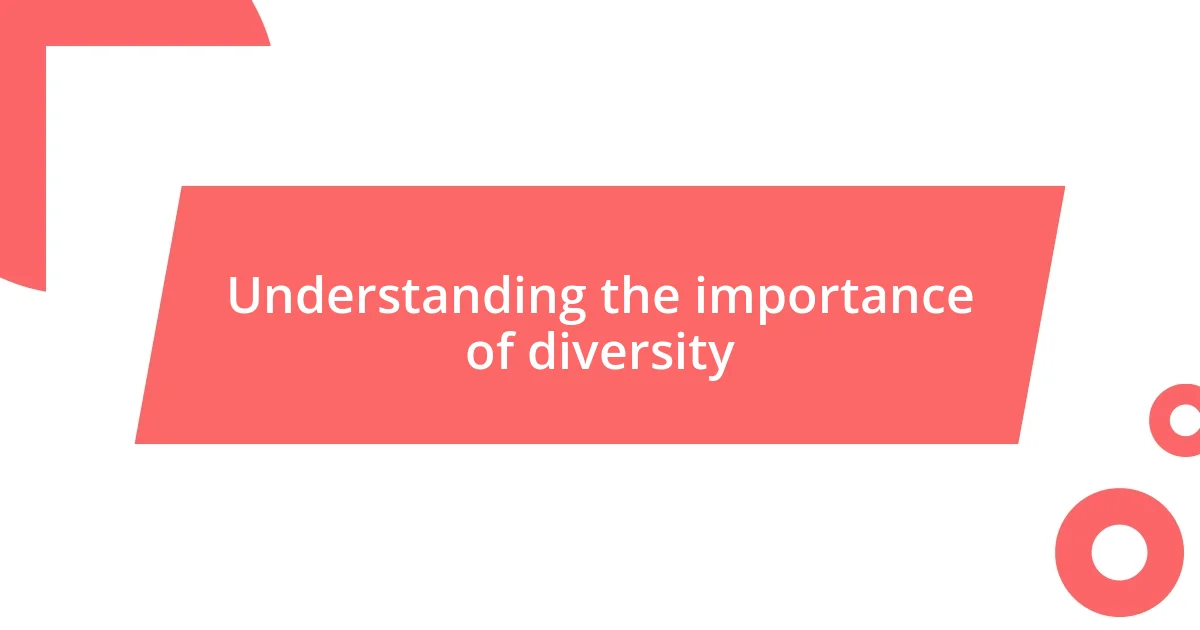
Understanding the importance of diversity
Diversity in sports teams brings a wealth of different perspectives and skills that can transform a group dynamic. I once played on a team where players hailed from various cultural backgrounds, and I was consistently amazed at how our differing approaches to training and strategy enriched our performances. Isn’t it fascinating to think about how one player’s unique insights can inspire a game-winning play?
When we embrace diversity, we open the door to creativity and innovation. I remember a moment during a tough game when we were facing an unexpected challenge. A teammate, whose background in a different sport offered a fresh viewpoint, suggested a tactic that none of us had considered. That simple shift not only changed our approach but also highlighted the power of diverse thinking. How often do we find ourselves boxed in by the same old strategies?
Furthermore, diversity fosters a sense of belonging and unity that can elevate team spirit. I’ve seen firsthand how teammates from different backgrounds come to support one another, creating a bond that transcends the sport itself. Isn’t that what we all seek? A shared purpose and connection with those around us can turn a team into a family, driving us towards our collective goals.
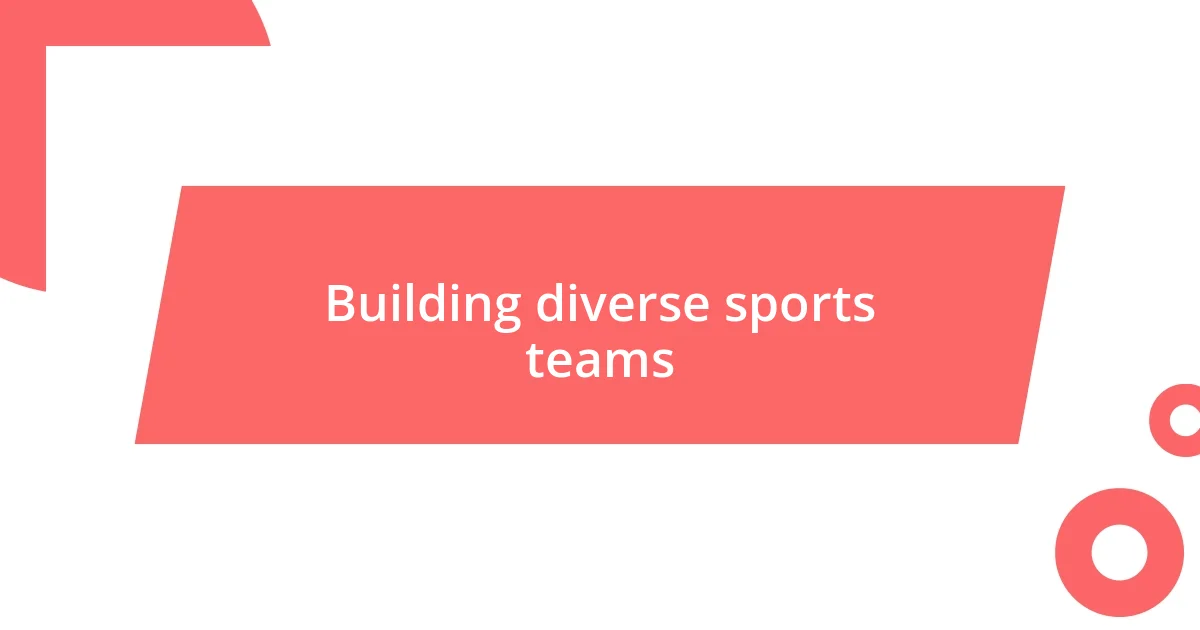
Building diverse sports teams
Building diverse sports teams is an intentional effort that can yield remarkable benefits. In my experience, recruiting players from a mix of backgrounds not only enhances skills but also encourages collaboration. I recall when I joined a team that valued diversity — the excitement was palpable as ideas flowed freely during our training sessions. Each practice felt like a brainstorming hub, where we’d dissect our game plan using a multitude of perspectives. This collaboration led to a deeper understanding of the sport, and our cohesive energy on the field was electric.
Here are a few key steps to effectively build a diverse sports team:
- Define clear values: Establish what diversity means for your team and include it in your mission statement.
- Encourage outreach: Actively seek players from various communities or backgrounds to broaden your recruitment.
- Cultivate an inclusive environment: Create a safe space where all voices are heard, ensuring everyone feels comfortable sharing ideas.
- Invest in team-building activities: Engage in events that celebrate different cultures, fostering bonding beyond the sport.
- Promote mentorship: Pair experienced players with newcomers from diverse backgrounds to encourage growth and camaraderie.
In my view, taking these steps not only helps in building a diverse team but also strengthens relationships, creating a winning culture both on and off the field.
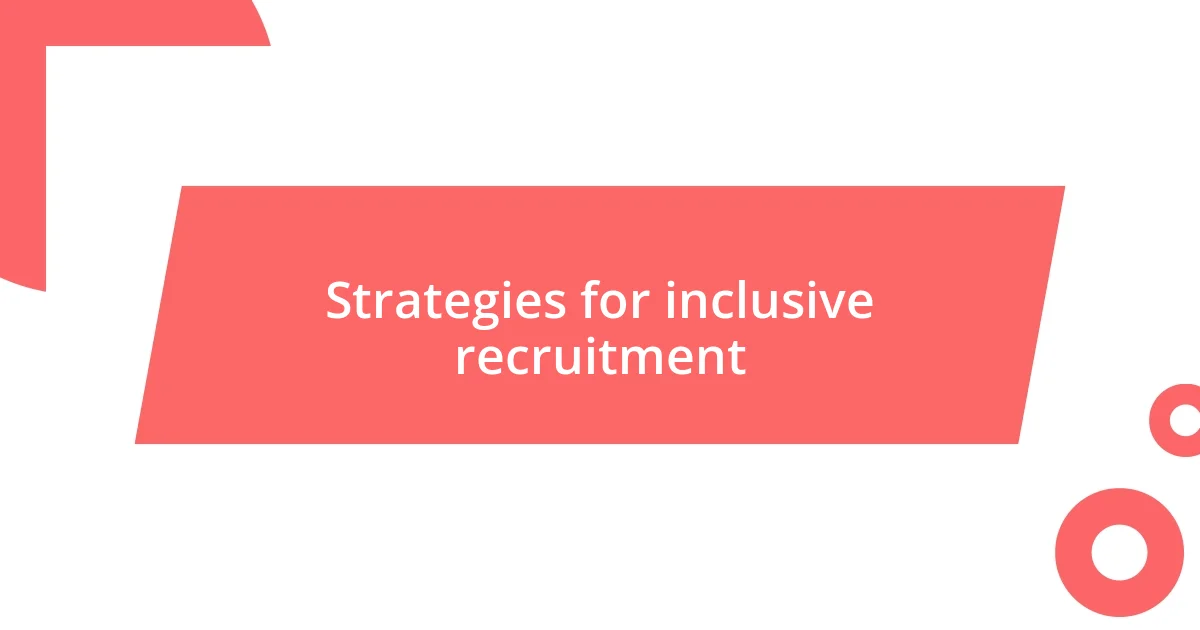
Strategies for inclusive recruitment
When it comes to inclusive recruitment, one effective strategy I’ve found is to leverage community partnerships. I remember collaborating with local schools and organizations to reach out to underrepresented groups. By doing this, we not only introduced the sport to a wider audience but also discovered hidden talent. Who knows what incredible skills are waiting to be uncovered in our own neighborhoods?
Another approach is to implement blind recruitment practices. This means focusing on a candidate’s skills and experiences without any biases related to their background. In one of my previous teams, we decided to anonymize our applications. The outcome was a refreshing mix of players who might have otherwise been overlooked. It was a lesson in how even small changes can bring profound benefits.
Lastly, it’s crucial to continuously evaluate our recruitment processes. By seeking feedback from diverse team members about their experiences, I realized areas where we could improve our outreach. This ongoing commitment not only strengthens our team but also builds trust within the community. What are some ways your team gathers feedback from players to identify blind spots?
| Strategy | Description |
|---|---|
| Community Partnerships | Collaborate with local organizations to reach diverse talent pools. |
| Blind Recruitment | Focus on skills and experiences without biases related to background. |
| Continuous Evaluation | Seek feedback from diverse team members to improve recruitment efforts. |

Creating an inclusive team culture
Creating an inclusive team culture requires intentional steps that invite everyone to participate fully. I remember the first team huddle after we implemented regular feedback sessions. Players who had been quiet before finally opened up, sharing their ideas and concerns. It was like watching the team transform overnight, as everyone felt empowered to contribute and invest in each other’s success.
In my experience, celebrating individual differences is a game-changer. One time, we organized a potluck where players brought dishes that represented their cultures. Not only did we enjoy a feast, but it also fostered conversations that deepened our connections. I found myself laughing and bonding over stories that showcased each person’s background. This sense of belonging was instrumental in building trust, which is essential for any team.
Lastly, it’s vital to model inclusive behaviors as leaders. I once made it a point to regularly highlight the achievements of every player, regardless of their position or background. By doing so, I wanted everyone to feel valued. Have you ever noticed how acknowledgment can spark motivation? That’s exactly what happened in our team – players lifted each other up, and the atmosphere shifted to one that prioritized collective growth over individual accolades.
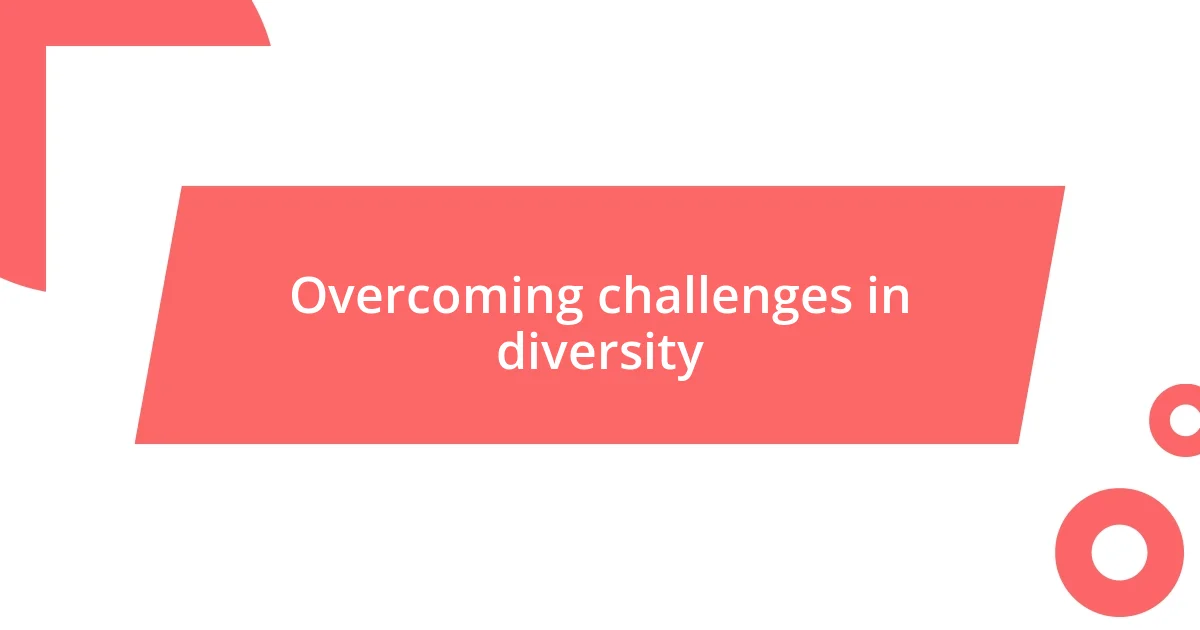
Overcoming challenges in diversity
Overcoming challenges in diversity often feels like navigating through a maze with unexpected turns. There was a particular moment when our team faced criticism for not being cohesive enough. I felt the tension in the air during practice sessions, which made me reflect on how we were embracing our differences. By emphasizing open dialogues, we not only addressed misunderstandings but also created deeper bonds. Have you felt that pressure in your own team settings?
One significant hurdle was managing conflicting communication styles. I recall a practice where two players, from different backgrounds, misinterpreted each other’s intentions. It struck me how easily miscommunication could disrupt our harmony. We held a workshop focused on active listening and emotional intelligence. I could see the shift in their dynamics as they began to appreciate and adapt to one another’s unique communication preferences. Didn’t it feel satisfying to watch such growth unfold?
It’s also important to recognize biases that may surface unconsciously. I distinctly remember the day I realized I was favoring players who mirrored my own background. Once I owned up to it, I initiated a team discussion, encouraging members to share their experiences with bias. This act of vulnerability sparked an empowering dialogue that cultivated understanding and accountability. Have you ever faced a similar revelation? Reflecting on our biases can truly strengthen our commitment to diversity.
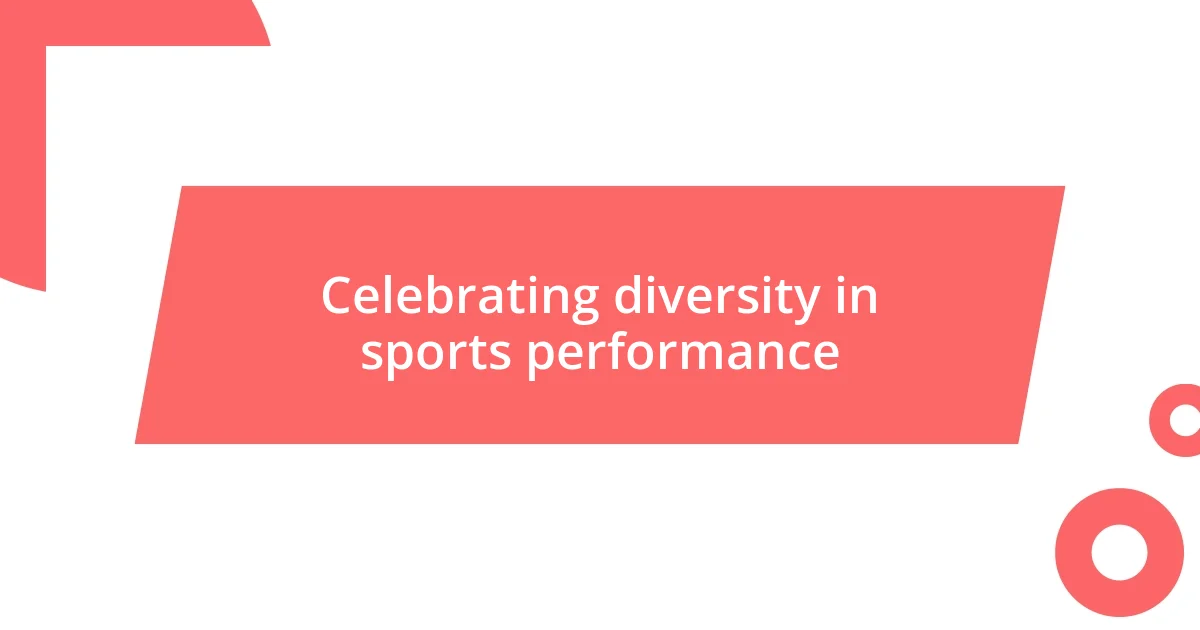
Celebrating diversity in sports performance
Celebrating diversity in sports performance is essential, as it unveils a treasure trove of strengths and perspectives. I remember a game where our diverse lineup brought unique styles to the field. Each player’s distinct approach created a dynamic synergy that overwhelmed our opponents. Watching it unfold was like seeing a masterful painting come to life, where every brushstroke added depth. Have you ever been part of a team where differences made the performance extraordinary?
I often think about the emotional resonance of those moments. During one intense match, we faced a setback, but it was our varied experiences that helped us rally. A player from a competitive background brought poise, while another’s artistic instincts led to creative solutions. Together, we didn’t just overcome adversity; we flourished. Doesn’t it feel powerful when diverse voices harmonize to tackle challenges?
Moreover, celebrating diversity also means amplifying the contributions of all team members. I recall a time when we spotlighted the achievements of players from different cultural backgrounds during our pre-game rituals. Those moments were priceless, allowing everyone to shine in their own light. This not only built confidence but also deepened our appreciation for one another. How impactful would it be to let every member feel like a star in their own right?
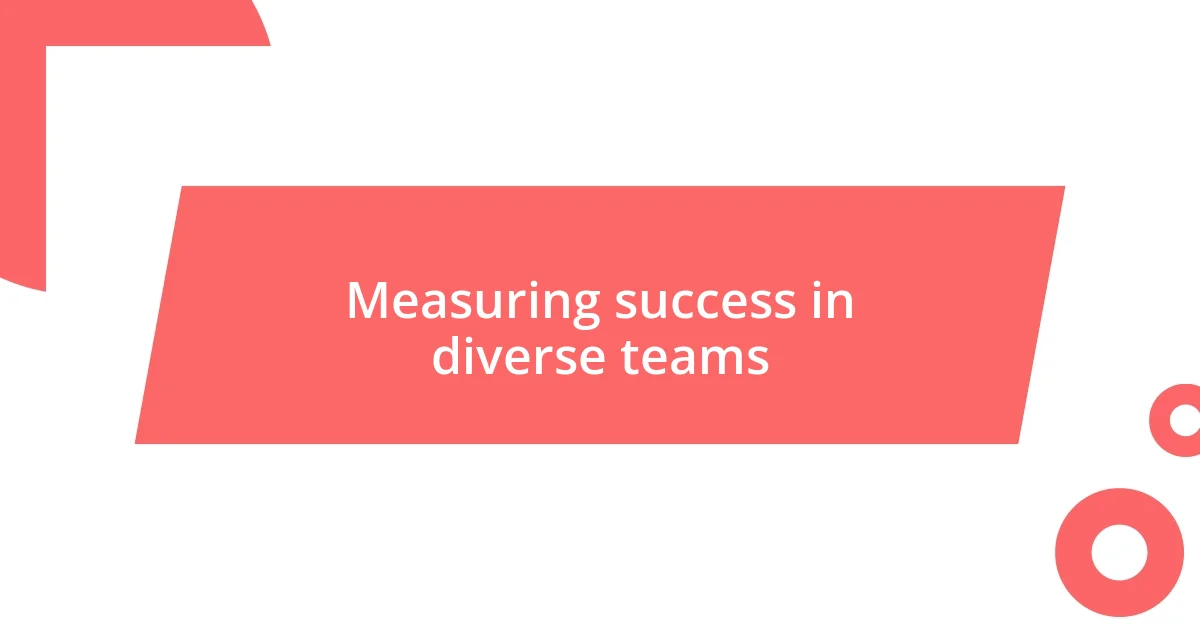
Measuring success in diverse teams
When I reflect on measuring success in diverse teams, I often find that traditional metrics don’t paint the full picture. For instance, during a particularly challenging season, wins and losses felt secondary to the atmosphere of inclusion we were nurturing. One day, I overheard two players discussing how they felt valued and understood for the first time in their sports journey. Those moments are priceless indicators of our success, aren’t they?
I remember a time when we implemented quarterly feedback sessions. The actual playing statistics were shared, of course, but it was the qualitative feedback that surprised me. Players expressed how collaboration and trust improved their performance, creating a tighter-knit unit on the field. Hearing such insights made me realize that success is not merely about numbers; it’s about growth and connection. Have you ever noticed how support within a team can propel individuals to perform better than they’d anticipate?
Ultimately, the happiness and cohesion of the team became my benchmark. In one memorable team-building retreat, I saw a once-quiet player step up and share their journey. It was a pivotal moment that highlighted the richness of our collective experiences. The smiles and nods around the room were evidence that we were not just teammates but a family. Isn’t that what we’re really striving for—success defined by the strength of our relationships?










